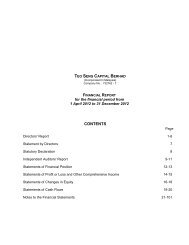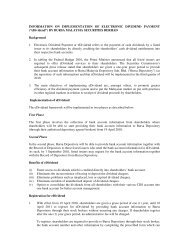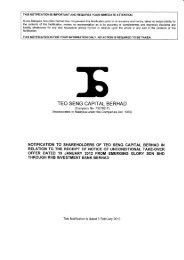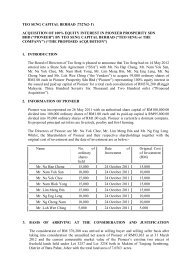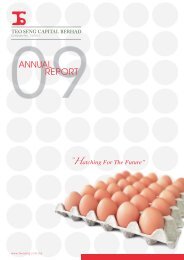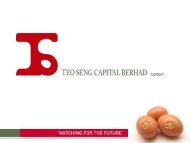Hatching For The Future - teo seng capital berhad
Hatching For The Future - teo seng capital berhad
Hatching For The Future - teo seng capital berhad
Create successful ePaper yourself
Turn your PDF publications into a flip-book with our unique Google optimized e-Paper software.
Teo Seng Capital Berhad<br />
Notes To <strong>The</strong> Financial Statements<br />
<strong>For</strong> <strong>The</strong> Financial Year Ended 31 March 2012<br />
4.<br />
ACCOUNTING POLICIES AND STANDARDS (cont’d)<br />
4.2<br />
Summary of Significant Accounting Policies (cont’d)<br />
(c) Property, plant and equipment and depreciation (cont’d)<br />
Surpluses arising on revaluation are recognised in other comprehensive income and accumulated in equity<br />
under the revaluation reserve. Any deficit arising from revaluation is charged against the revaluation reserve to<br />
the extent of a previous surplus held in the revaluation reserve for the same property, plant and equipment. In<br />
all other cases, a decrease in carrying amount is charged to profit or loss. Subsequent to revaluation, any<br />
addition is stated at cost whilst disposal is stated at cost or valuation as appropriate.<br />
Freehold land is not depreciated whilst <strong>capital</strong> work-in-progress are not depreciated until they are completed<br />
and put into use. Leased assets are depreciated over the shorter of the lease term and their useful lives<br />
unless it is reasonably certain that the Group will obtain ownership by the end of the lease term. Other<br />
property, plant and equipment are depreciated on a straight-line basis to write off the cost of each asset to its<br />
residual value over the estimated useful lives. Depreciation of an asset does not cease when the asset<br />
becomes idle or is retired from active use unless the asset is fully depreciated. <strong>The</strong> principal annual rates of<br />
depreciation used are as follows :<br />
Farm and poultry buildings 2% - 20%<br />
Factory buildings 1% - 2%<br />
Fish pond and equipment 2% - 10%<br />
Plant and machinery 5% - 20%<br />
Egg layer conveyor and cages system 5%<br />
Motor vehicles, electrical installation, furniture, fittings, equipment, renovation and hostel 2% - 33.3%<br />
<strong>The</strong> residual values, useful lives and depreciation method are reviewed at the end of each reporting period to<br />
ensure that the amount, method and period of depreciation are consistent with previous estimates and the<br />
expected pattern of consumption of the future economic benefits embodied in the items of property, plant<br />
and equipment.<br />
<strong>The</strong> carrying amounts of property, plant and equipment are reviewed for impairment when events or changes<br />
circumstances indicate that the carrying amounts may not be recoverable. <strong>The</strong> policy for the recognition and<br />
measurement of impairment losses is in accordance with Note 4.2(f)(ii).<br />
An item of property, plant and equipment is derecognised upon disposal or when no future economic benefits<br />
are expected from its use. <strong>The</strong> difference between the net disposal proceeds, if any, and the carrying amount<br />
is recognised in profit or loss and the unutilised portion of the revaluation surplus on that item, if any, is<br />
transferred directly to retained profits.<br />
(d)<br />
(e)<br />
Assets under hire purchase<br />
Assets acquired under hire purchase are <strong>capital</strong>ised in the financial statements and are depreciated in<br />
accordance with the policy set out in Note 4.2(c) above. Each hire purchase payment is allocated between the<br />
liability and finance charges so as to achieve a constant rate on the finance balance outstanding. Finance<br />
charges are recognised in profit or loss over the period of the respective hire purchase agreements.<br />
Investment property<br />
Investment property is property held either to earn rental income or for <strong>capital</strong> appreciation or for both.<br />
Initially, investment property is measured at cost including transaction costs, less accumulated depreciation<br />
and impairment losses, consistent with the accounting policy for property, plant and equipment.<br />
Annual Report 2012<br />
47



